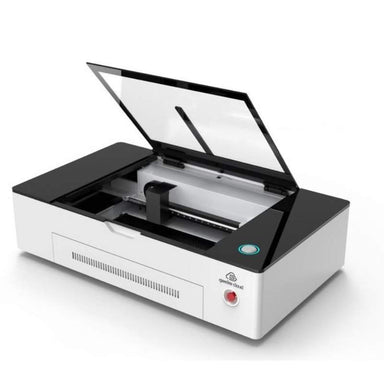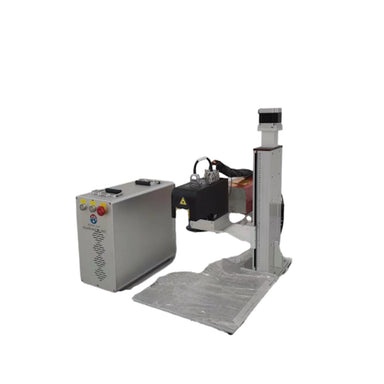 Sale
Sale
Complete your laser engraving toolchest with the ComMarker Omni 1 UV Laser Engraver and unlock more than 1,500+ materials. Multiply the types of p...
View full detailsLaser engravers give makers, small businesses, and institutions the power to cut, etch, and personalize with precision across wood, metal, acrylic, leather, glass, and more. Whether you’re working with a wood laser engraver for creative projects, a fiber laser engraver for industrial marking, or a desktop laser engraver for a home workshop, today’s laser engraving machine technology makes professional results more accessible than ever. From fine art and signage to manufacturing and product branding, laser engravers play a central role in modern fabrication.
Our collection of laser engravers includes carefully selected systems for every skill level and application—whether you need a laser engraver for wood, a laser engraver for metal, or a versatile hybrid solution. These machines are trusted by makers, educators, fabrication shops, and production environments for their speed, reliability, and clean results. If you’re looking for a laser etching machine that delivers consistent output, scalable performance, and real-world durability, you’ll find the right solution here.
 Sale
Sale
Complete your laser engraving toolchest with the ComMarker Omni 1 UV Laser Engraver and unlock more than 1,500+ materials. Multiply the types of p...
View full details Save $1,000.00
Save $1,000.00
Bring portable engraving power to the next level with the Gweike G2 Max 50W fiber laser engraver that redefines precision and power. Discover next-...
View full details Sale
Sale
Redefine UV Engraving with the Omni X: Precision, Speed, and Safety in One Powerhouse. ComMarker Omni X Laser, this isn’t just another engraver—it...
View full details Sale
Sale
ComMarker Omni XE UV Laser Engraver — Redefining Ultra-Fine Precision for Industrial & Creative Engraving Elevate your engraving capabilities w...
View full details Save $305.00
Save $305.00
FLUX Beamo 30W Laser Cutter & Engraver: The World's Smallest Desktop CO2 Laser Engraver and Cutter. Bring your creative ideas to life with the...
View full details Sale
Sale
Unmatched Precision and Versatility for High-Quality Engraving: Introducing the Haotian JPT MOPA Split Fiber Laser Engraver. Unlock the power of p...
View full details Sale
Sale
Introducing the ComMarker Titan 1 JPT MOPA Fiber Laser Engraver - the ultimate solution for professionals who demand the best. The ComMarker Titan ...
View full details Sale
Sale
Delivery Time: The OneLaser XRF Series will ship after 2 weeks and take another week or more to deliver, depending on your location in the USA. Unl...
View full details Sale
Sale
Unlock the Future of Precision Marking with the Gweike G6 Split Fiber Laser. Introducing the Gweike G6 Split Fiber Laser, the ultimate solution for...
View full details Save $400.00
Save $400.00
Meet the Laser Pecker 2 - the ultimate tool for DIY enthusiasts, crafters, and small-scale professionals. Unlock your creativity and elevate your D...
View full details Sale
Sale
The ComMarker B4 Fiber Laser is a groundbreaking marking machine designed to redefine engraving with unmatched precision, speed, and versatility. ...
View full details Sale
Sale
Introducing the ComMarker B6: The Precision Powerhouse for your Metal Engraving Needs. Unlock a new era of smart metal color engraving with the Co...
View full details Sale
Sale
Make your mark with the LaserPecker LP5 - the most capable, lightest, and most compact engraver in its class. Unlock a world of creative possibilit...
View full details Save $500.00
Save $500.00
Elevate your engraving game with the Gweike G2 Pro 30W, the cutting-edge fiber laser engraver that redefines precision and power. Experience the fu...
View full details Sale
Sale
Unleash a powerhouse of laser precision in your workspace with the Gweike Cloud 50W CO2 Laser Cutter & Engraver. Introducing the Gweike Cloud 5...
View full details Sale
Sale
[Pre-Sale Notice]: The LaserPecker LP2 Plus is in pre-sale and the will only be shipping out to customers in the USA in early December 2025. Meet t...
View full details Save $800.00
Save $800.00
Unleash Your Workshop’s Potential with the Sculpfun S40 Max Laser Cutting Machine! Elevate your creative endeavors with the SCULPFUN S40 Max, a pro...
View full details Sale
Sale
Unleash Limitless Creativity with the Longer Nano Duo AI Dual Source Laser Engraver! The Longer Nano Duo AI Dual Source Laser Engraver redefines wh...
View full details Sale
Sale
Supercharge your creativity with the Longer B1 Diode Laser Engraving Machine! Step into a new era of laser engraving with the Longer B1 Diode Laser...
View full details Save $0.00
Save $0.00
Unleash Limitless Creativity with the FLUX Beambox II 55W Desktop CO2 Laser Cutter. Introducing the all-new Beambox II — a powerhouse of a desktop...
View full details Sale
Sale
Pre-Sale Notice / Delivery Time: Hydra 7 and Hydra 9 have a 50 working days pre-sale delivery time while Hydra 13 has 80 working days and Hydra 16 ...
View full details Sale
Sale
Achieve Unparalleled Precision and Versatility with the Haotian 3D Feeltek UV Galvo Laser Engraver: Engrave curved surfaces with ease. Unlock your...
View full details Sale
Sale
Precision and Power for Industrial-Grade Marking: Introducing the Haotian JPT Split Fiber Laser Engraver. Unlock your company's engraving potential...
View full details Sale
Sale
Delicate Precision Meets Powerful Performance: Introducing the Haotian UV Galvo Laser Engraver. The Haotian UV Galvo Laser Engraver is engineered f...
View full detailsA laser engraver is a machine that uses focused laser energy to etch, mark, or cut materials with extreme accuracy. A laser engraving machine can permanently mark designs, text, barcodes, and images onto surfaces like wood, metal, plastic, glass, leather, and stone. Many people also refer to these as a laser etching machine, especially when used for surface marking rather than cutting.
Laser engravers can work on a wide range of materials depending on the laser type. A wood laser engraver is ideal for wood, MDF, leather, rubber, and acrylic. A laser engraver for metal—typically a fiber laser engraver—can engrave stainless steel, aluminum, brass, copper, coated metals, and anodized surfaces. Some systems are designed specifically for fine marking on plastics, glass, ceramic, and coated products.
The main difference is the type of materials each machine is designed to process. A wood laser engraver (usually CO₂ or diode-based) excels at cutting and engraving organic materials like wood, leather, and acrylic. A fiber laser engraver is purpose-built for high-speed, permanent metal engraving, making it the best choice for industrial marking, deep etching, and part identification on metals.
The price of a laser engraving machine varies widely based on power, size, and laser type. Entry-level desktop laser engravers can start in the low thousands, while professional-grade wood laser engravers and hybrid systems fall into the mid-range. Industrial laser engraver for metal systems, especially fiber models, can reach higher price points due to their power, speed, and metal-processing capability.
Yes, a desktop laser engraver is one of the most popular choices for small businesses. These systems are widely used for custom gifts, signage, product branding, jewelry, leather patches, and promotional items. They offer a strong balance of affordability, compact size, and professional engraving quality, making them ideal for home shops and growing production workflows.
Laser engraving removes deeper material to create a recessed mark, while laser etching changes the surface layer through heat to create contrast. In everyday use, the terms laser engraving machine and laser etching machine are often used interchangeably. The actual result depends on laser power, speed, material type, and focus settings rather than the machine category itself.
Shipping Insurance ($89)

